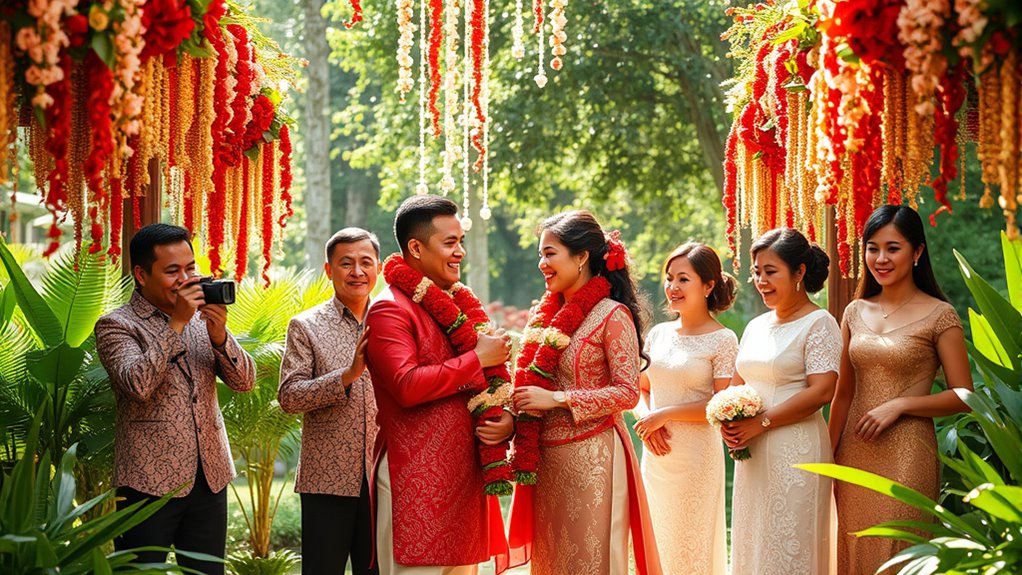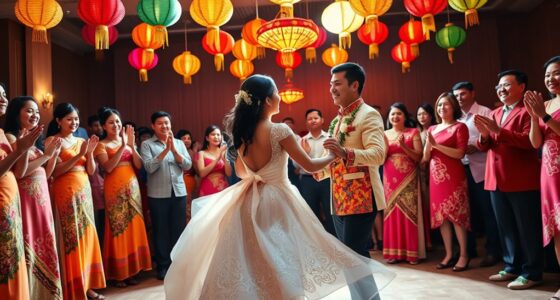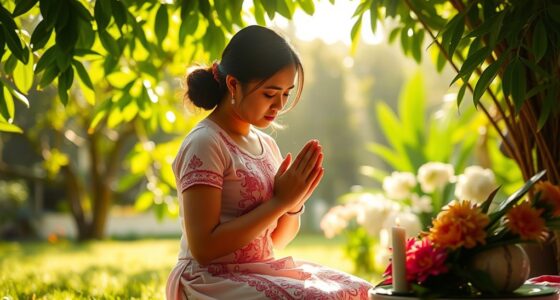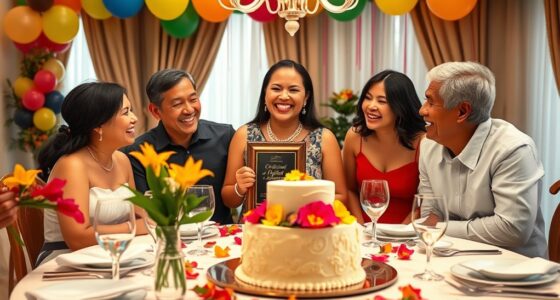Filipino post-wedding traditions are vibrant and filled with cultural significance. You’ll see lively celebrations featuring a money dance for financial support and the release of doves symbolizing peace. Enjoy traditional foods like lechon and pancit, representing abundance and long life. Community involvement is key, with extended family and sponsors providing support. Rituals like the unity candle and the garter toss strengthen connections. Discover more about the rich diversity and modern influences shaping these beautiful customs.
Key Takeaways
- The Money Dance allows guests to pin money on the couple, symbolizing financial support and community involvement.
- Releasing doves during the celebration signifies peace and love as the couple begins their new life together.
- Traditional foods like lechon and pancit are served to symbolize abundance and long life, enhancing the festive atmosphere.
- Family members actively participate in rituals such as the bouquet toss and garter retrieval to predict future marriages within the community.
- Unity ceremonies, like the lighting of candles, represent the merging of families and the couple’s commitment to each other.
Post-Wedding Celebrations

Post-wedding celebrations in Filipino culture are vibrant and filled with meaningful traditions that bring families and communities together.
One of the highlights is the Money Dance, where guests pin money onto your clothing, supporting you financially as you start your new life. You’ll also witness the release of doves, symbolizing peace and love, while engaging in lively music and dance that foster a celebratory atmosphere. The incorporation of traditional elements such as the retrieval of the garter and bouquet toss adds a fun twist, predicting the next couple to wed. Family involvement is essential, with everyone participating in rituals that emphasize unity and support.
These customs not only celebrate your marriage but also strengthen community ties and preserve cultural heritage.
Traditional Foods
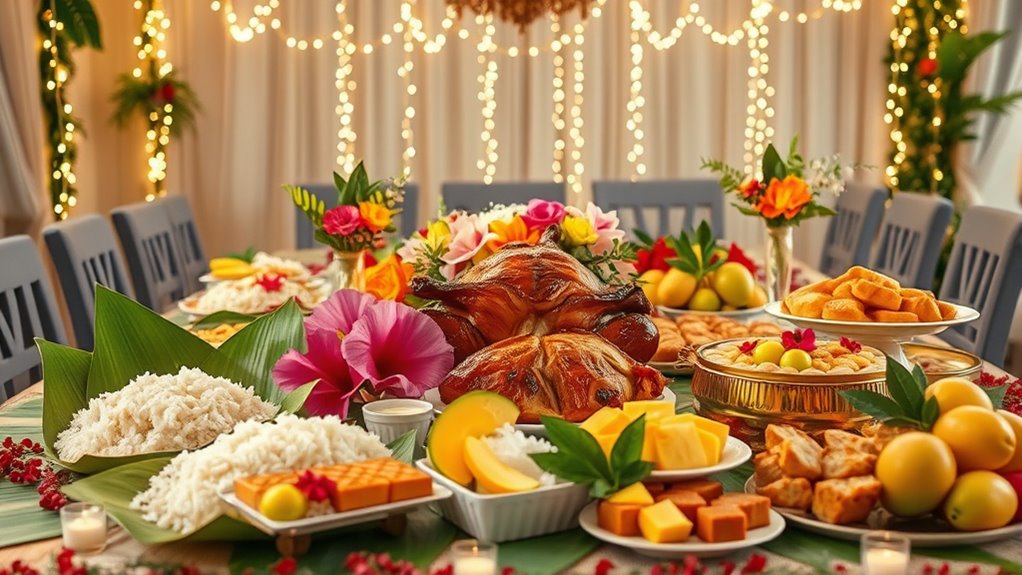
When you celebrate a Filipino wedding, traditional foods take center stage, reflecting the culture’s rich history and values. One of the highlights is lechon, a whole roasted pig symbolizing abundance and festivity. You can expect pancit, usually served in varieties like Canton or Bihon, representing long life. Adobo, a staple dish made with chicken or pork, adds comfort with its savory flavors. Sinigang na baboy, a sour stew, brings warmth, while lumpiang Shanghai, deep-fried spring rolls, serve as a delightful appetizer. Celebratory food includes a mix of traditional and regional flavors, ensuring that every guest experiences the vibrant culinary heritage of the Philippines.
These dishes often incorporate local ingredients, prepared in large quantities to share with guests. Each bite carries cultural significance, making the meal not just delicious but an essential part of the celebration, connecting everyone through flavor and tradition.
Community Involvement
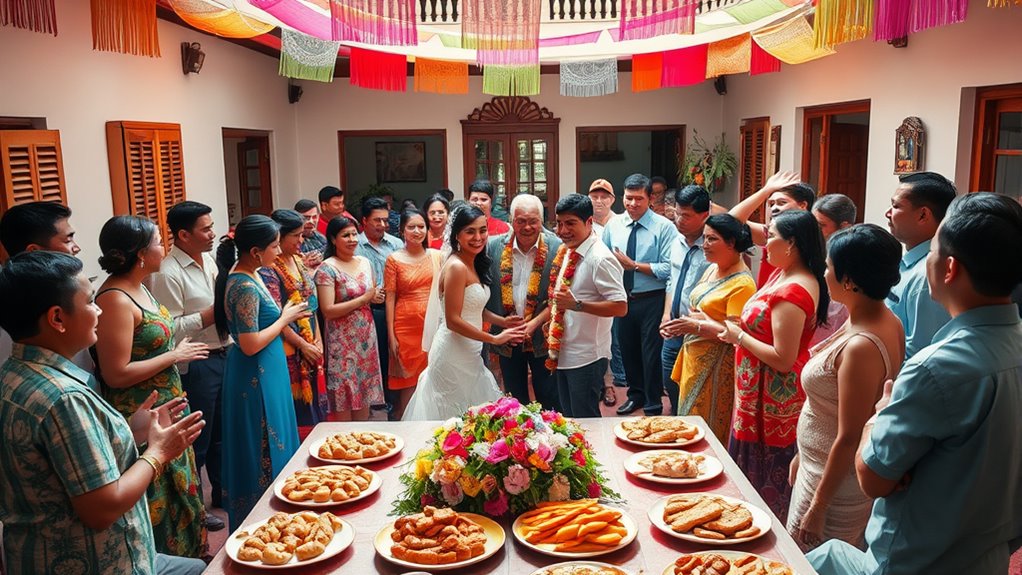
Community involvement is a cornerstone of Filipino weddings, where families and friends come together to celebrate love and unity. Extended family members actively participate, reflecting the significance of community bonds.
Often, Filipino community centers serve as wedding venues, inviting everyone to join the festivities. Lively receptions feature traditional folk dances and cultural performances, showcasing the couple’s heritage. Guests participate in meaningful ceremonies, like the candle and veil rites, reinforcing connections.
Wedding sponsors, or ninongs and ninangs, play crucial roles, offering support, guidance, and sometimes financial help. The overall celebration invites the broader community, fostering unity and respect for elders, while traditions like the money dance allow guests to contribute financially, making the event even more memorable.
Rituals and Ceremonies
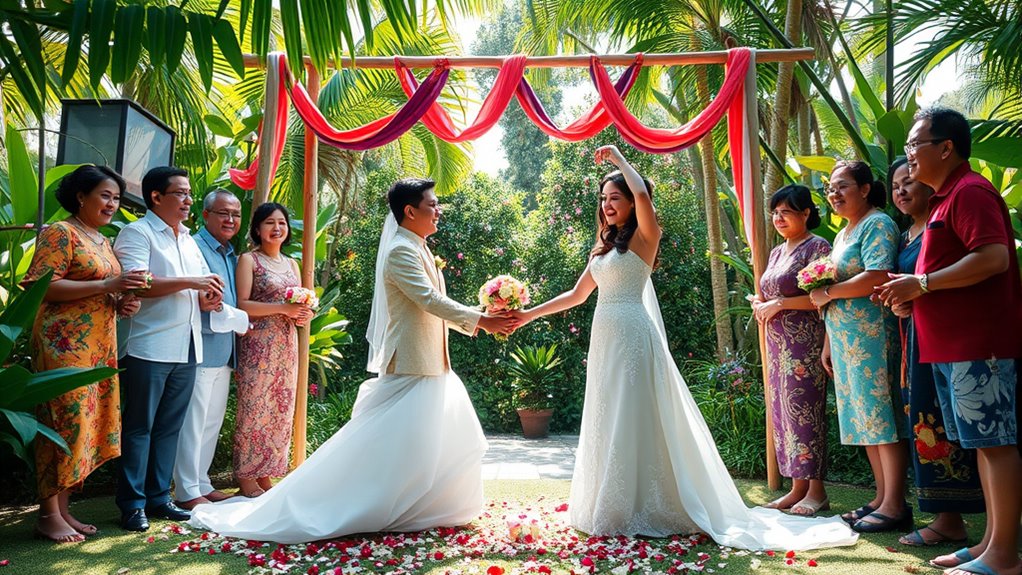
Celebrations in Filipino weddings extend beyond just community involvement; they encompass a rich tapestry of rituals and ceremonies that deepen the couple’s bond.
One significant ritual is the release of doves, symbolizing peace and love. You’ll also witness the unity candle, representing the merging of lives and families. The groom presents 13 coins, known as arrhae, to signify his financial commitment.
The release of doves and the unity candle beautifully symbolize the couple’s love and commitment in Filipino weddings.
Secondary sponsors light candles, representing God’s presence during the ceremony. Food traditions play a role too, with dishes like Sotanghon Soup served for warmth and good fortune.
Each of these elements contributes to the ceremony’s significance, ensuring a memorable experience that honors both families and their union.
Cultural Significance
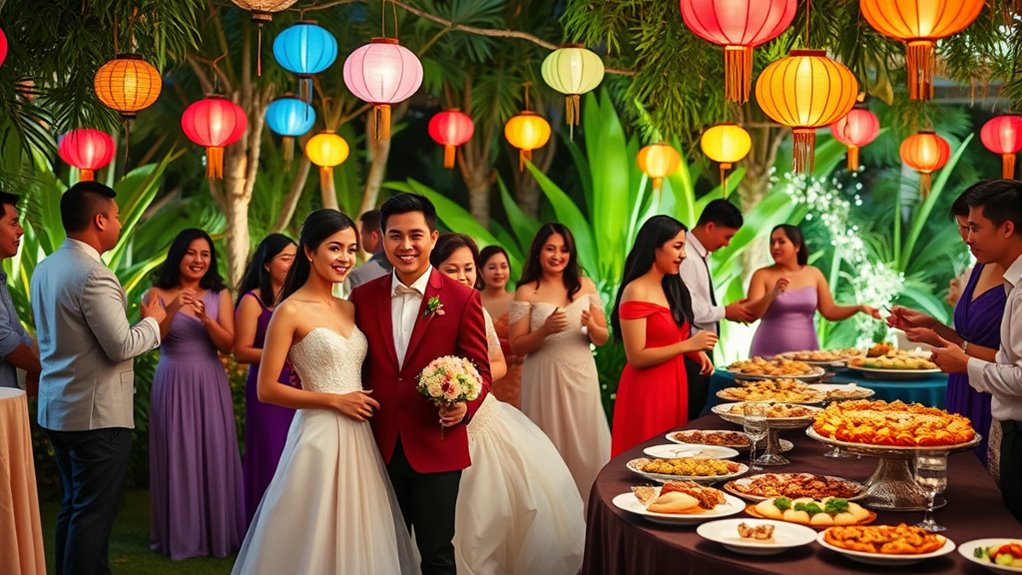
Although many aspects of Filipino weddings are steeped in tradition, their cultural significance extends far beyond mere ceremony. The blend of Spanish influence and Catholic traditions showcases a rich cultural tapestry, emphasizing family unity and community support.
You’ll notice that the inclusion of principal sponsors not only reflects the couple’s social standing but also highlights the community’s role in their union. Traditions like the money dance symbolize collective support for the newlyweds, reinforcing social ties.
Additionally, symbols such as the unity candle and cord and veil embody the merging of families. Each wedding feast, vibrant and celebratory, emphasizes community joy and the importance of family blessings, making these ceremonies essential to Filipino cultural identity and values.
Regional Variations
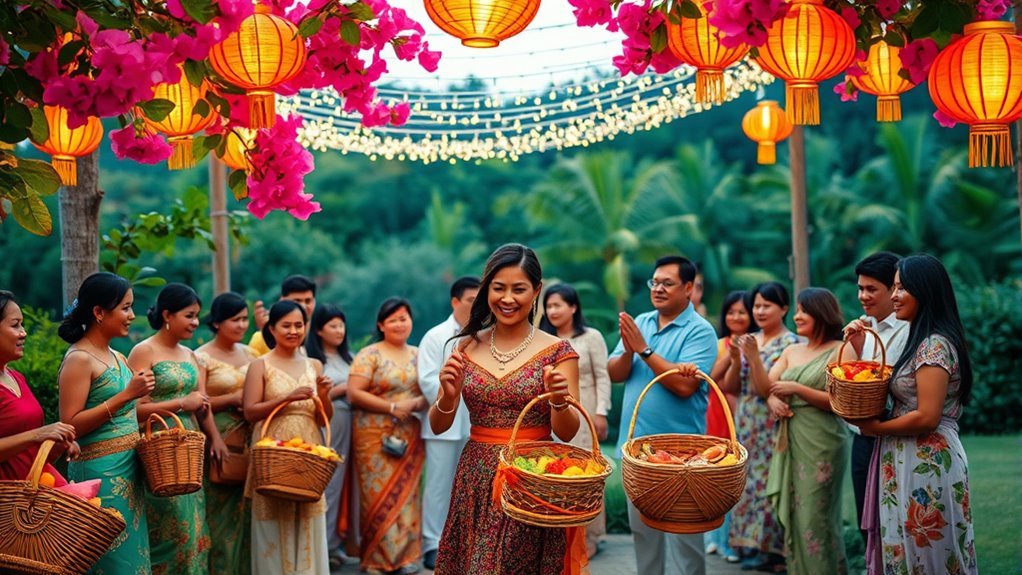
Filipino wedding traditions vary markedly across regions, reflecting the diverse cultural landscapes of the archipelago.
In Northern Luzon, you might encounter indigenous practices mixed with Catholic elements. The Visayas region blends Western customs with local traditions, focusing heavily on family gatherings.
In Mindanao, Muslim customs like the Kagen and Taltag are prominent, involving dowry offerings and spiritual cleansing rituals. Ifugao groups celebrate with the *takik* dance to seek blessings from their god.
Filipino-Chinese couples often partake in the Ting Hun Ceremony, exchanging gifts and red envelopes.
Across regions, the Pamamanhikan and Pa-alam traditions emphasize family approval and intentions to marry, showcasing the importance of familial ties in Filipino culture.
Modern Influences on Traditions
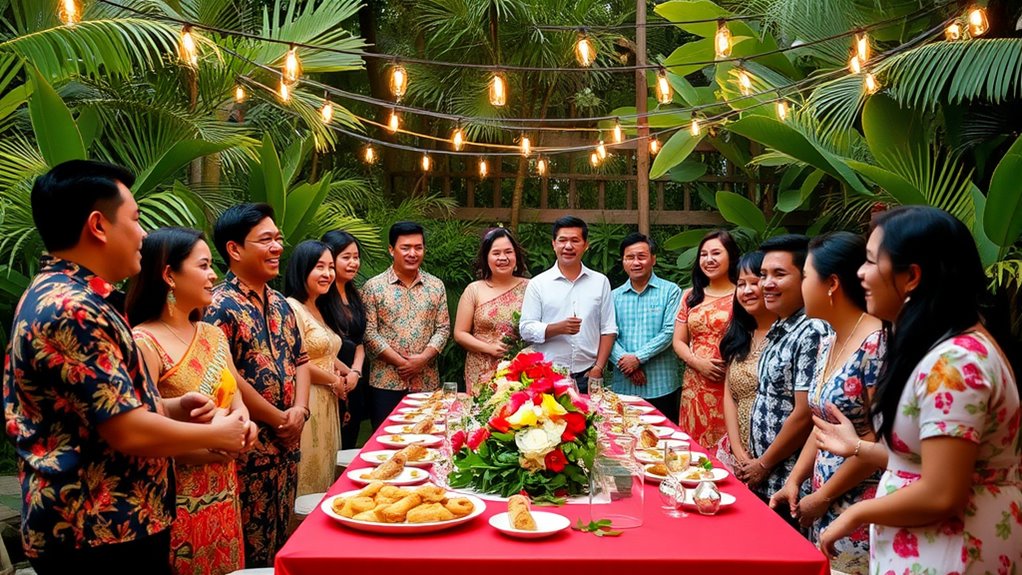
As modern influences reshape Filipino post-wedding traditions, many couples find themselves blending cherished customs with contemporary practices.
You might notice a shift towards Western-style weddings, with white gowns and tuxedos becoming popular in urban areas. Non-church ceremonies often take center stage, emphasizing intimate family gatherings over grand celebrations.
Intercultural unions bring new customs into the mix, like the unity candle ceremony, symbolizing the union of lives. While community support remains essential, couples increasingly lean on professional planners, reflecting a modernized bayanihan spirit.
Intercultural weddings blend traditions, embracing new rituals like the unity candle ceremony while honoring community support through modern planning.
Many now prefer smaller, personal gatherings, moving away from traditional large events. Technology also plays a role, with live streaming and digital invitations enhancing the experience while promoting eco-friendly practices.
Frequently Asked Questions
What Attire Do Guests Typically Wear at Filipino Weddings?
At Filipino weddings, you typically wear conservative attire to honor the occasion.
Women often choose elegant dresses or formal skirts with blouses, while men usually opt for long-sleeved shirts, with the Barong Tagalog being a popular choice.
Lighter fabrics are common due to the warm climate, especially for outdoor ceremonies.
Accessories should be stylish yet respectful, enhancing your look without overshadowing the couple on their special day.
How Long Do Filipino Wedding Celebrations Usually Last?
Filipino wedding celebrations can last up to three days, depending on the traditions followed.
The main ceremony usually lasts 1-2 hours, but the festivities continue with a reception that might go for several hours.
You’ll enjoy traditional food and entertainment throughout the event.
While modern weddings often focus on a single day, the rich customs and celebrations can extend the joyous occasion, allowing for more memorable experiences with family and friends.
Are There Specific Gifts Expected for the Couple?
When it comes to gifts for the couple, you’ll find that practical items often take precedence.
Kitchen essentials like pots and pans are always appreciated, along with home furnishings like linens or mattresses.
Monetary gifts are common, especially from close family and ninongs and ninangs.
Personalized or cultural items can also make a thoughtful impact.
Ultimately, it’s the thoughtfulness behind your gift that matters most in Filipino culture.
What Role Do Children Play in Post-Wedding Traditions?
Did you know that around 70% of Filipino weddings involve children in some form?
In post-wedding traditions, kids often participate in lively dances, symbolizing joy and unity. They might also help in traditional practices, like the money dance, by carrying money for guests to pin on the couple.
Their involvement not only adds to the celebratory atmosphere but also strengthens family bonds, ensuring cultural practices are passed down through generations.
How Can Non-Filipinos Respectfully Participate in These Traditions?
To respectfully participate in Filipino post-wedding traditions, you can embrace the rituals with an open heart.
Attend family gatherings, engage in ceremonies, and enjoy traditional dishes to show appreciation for the culture.
Wear appropriate attire, like the Barong Tagalog or Filipiniana, to honor the customs.
Conclusion
In celebrating Filipino post-wedding traditions, you embrace community, you honor heritage, and you create lasting memories. By participating in these festivities, you connect with family, you savor traditional foods, and you engage in meaningful rituals. Each element reflects the rich cultural tapestry that defines Filipino life. So, as you explore these customs, remember: it’s not just about the event; it’s about the love shared, the bonds strengthened, and the stories passed down through generations.
